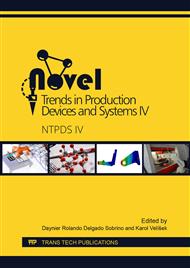[1]
G.M. Krolczyk, S. Legutko, R.W. Maruda, Influence of technological cutting parameters on surface texture of austenitic stainless steel, Applied Mechanics and Materials, Vol. 693, 2014, pp.430-435.
DOI: 10.4028/www.scientific.net/amm.693.430
Google Scholar
[2]
P. Kovac, B. Savkovic, D. Rodic, M. Gostimirovic, M. Sekulic, D. Jesic, Application of neuro-fuzzy systems for modeling surface roughness parameters for difficult-to-cut steel, Solid State Phenomena, Vol. 261, 2017, pp.277-284.
DOI: 10.4028/www.scientific.net/ssp.261.277
Google Scholar
[3]
J. Stahovec, M. Vrabel, L. Kandrac, J. Beno, I. Mankova, Study of cusp height in the ball-end milling process, Development in Machining Technology, Vol. 3. 2013, pp.51-61.
Google Scholar
[4]
B. Miko, Surface quality prediction in case of steep free form surface milling, Key Engineering Materials, Vol. 686, 2016, pp.119-124.
DOI: 10.4028/www.scientific.net/kem.686.119
Google Scholar
[5]
G. Varga, Effects of Technological Parameters on the Surface Texture of Burnished Surfaces, Key Engineering Materials, Vol. 581: Precision Machining VII, 2014, pp.: 403-408.
DOI: 10.4028/www.scientific.net/kem.581.403
Google Scholar
[6]
S. Sheth, P.M. George, Experimental Investigation and Prediction of Flatness and Surface Roughness During Face Milling Operation of WCB Material, Procedia Technology, Vol. 23, 2016, pp.344-351.
DOI: 10.1016/j.protcy.2016.03.036
Google Scholar
[7]
M.H. Ali, B. A. Khidhir, M.N.M. Ansari, B. Mohamed, FEM to predict the effect of feed rate on surface roughness with cutting force during face milling of titanium alloy, HBRC Journal, Vol. 9, Issue 3, 2013, pp.263-269.
DOI: 10.1016/j.hbrcj.2013.05.003
Google Scholar
[8]
P. Demircioglu, M.N. Durakbasa, Investigations on machined metal surfaces through the stylus type and optical 3D instruments and their mathematical modeling with the help of statistical techniques, Measurement, Vol. 44, 2011, p.611–619.
DOI: 10.1016/j.measurement.2010.12.001
Google Scholar
[9]
J. Kundrák, K. Gyáni, C. Felho, I. Deszpoth, The effect of the shape of chip cross section on cutting force and roughness when increasing feed in face milling, Manufacturing Technology, Vol. 17: (3), 2017, pp.335-342.
DOI: 10.21062/ujep/x.2017/a/1213-2489/mt/17/3/335
Google Scholar
[10]
F. Holesovsky, M. Novak, Grinding and its influence to ground surface durability, in: AIP Conference Proceedings, Vol. 1315(1), 2011, pp.973-978.
DOI: 10.1063/1.3552579
Google Scholar


